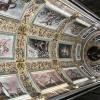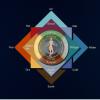The Medieval Worldview
Commentary
In the 7th century, Bishop Isidore of Seville codified the contemporary knowledge of the universe in his De Natura Rerum (On the Nature of Things). In addition to text, Isidore's manuscript depicted several diagrams displaying the structure of the world in a schematic form.
The diagram above shows the medieval understanding of the sublunary world. During this period, as in Greco-Roman antiquity, the universe was fundamentally divided into the 'upper', celestial world and the 'lower', natural world. The boundary between them was the Moon: above it lay a quasi-divine world of planets and stars. This world was investigated by astronomy (or astrology), while the lower world belonged to natural philosophy, or simply philosophy. The standard astronomical view (of the worlds above) is described here.
The world (Mundus) of natural philosophy was comprised of four elements: Earth, Water, Air, and Fire. The elements were not equal; the basest was the Earth, which lay at the centre and lowest point of the universe, and the best, Fire, which lay just below the Moon. Yet this hierarchical view was not the whole story: as Aristotle himself maintained, and Isidore confirmed, the elements were constantly being changed into each other in a circular motion. The 'wheel' view was important because, for instance, Fire cannot be directly converted into Water, but it had to be transformed into Air first, as the diagram suggests.
The reason they could be transformed into each other is because the elements were themselves comprised of 'qualities', which were two pairs of opposites: hot and cold, wet and dry. The combination of these qualities yielded the elements themselves. The diagram attempts to show how the qualities combine to create the elements: for instance, wet + cold = Air, while dry + hot = Fire. The qualities also allow the reconciliation of apparently opposed elements, such as Water and Fire. Read here more about the relationship between qualities and elements.
The Isidorian chart also shows that the qualities also yield the seasons: wet + cold = winter, dry = hot = summer. Together they create the 'year' (annus). As in the case of the elements, the emphasis is on the change of the seasons by means of the qualities of heat and humidity.
The qualities also combined to make up the humours of the body according to Galenic medicine. There is a striking similarity between the humours and the elements: for instance, the wet + cold = phlegm (here called simply humor), while dry + hot = yellow bile (cholera). Read here more on the four humours.
There is hence a strong relationship between the world (made up of elements), the human body (made up of humours) and the year (made up of seasons). This is expressed in the central correlation. The connection between the 'great' world (macrocosm) and the 'small' world of the human being (microcosm) is also implicit in this diagram. The emphasis is on the harmony of the universe, which follows a circular pattern and thereby reconciles all opposites.
Commentary. Georgiana D. Hedesan (Feb 2021).
Sources. Barbara Obrist, 'Le diagramme isidorien des saisons, son contenu physique et les représentations figuratives', in Mélanges de l'École française de Rome. Moyen Age 108:1 (1996), 95-164. doi: https://doi.org/10.3406/mefr.1996.3481


